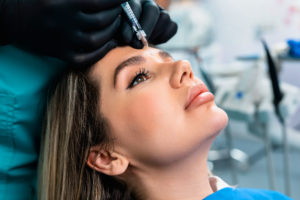George Orwell once said that, by 50, everyone has the face he deserves. These days, most 50-something female celebrities seem to have exactly the same face, which they paid for. Cheeks are stuffed like upholstery. Foreheads are stretched taut as timpani skins. Once in a while, a definite expression struggles to emerge before collapsing back into nothingness, defeated.
At the moment the artist still somewhat recognisable as Kylie Minogue has a new single out, and it’s being touted as the song of the summer. It is indeed great. Padam Padam is spooky, shivery, synthy, and insanely catchy. Its rhythm is basic enough to make your hips twitch even while you’re imploring them not to.
The title is a vague tribute to a 1951 song by Edith Piaf of the same name. But whereas Piaf’s voice is unmistakably distinctive, Kylie’s vocal is delivered with all the bland anonymity of a virtual assistant. The song is just short and sweet enough to edge the listener into mindlessly clicking and re-clicking the back button, desperate for an aural climax that never comes.
The whole experience is gloriously artificial: fake instruments, fake voice, fake emotion. So perhaps the extension of this theme into the realm of the physical shouldn’t matter too much. But it does. Once the home of extravagant youthful mobility, Kylie’s facial muscles now seem confined to tiny asymmetric movements — disdainful lip curls or slightly demented eyebrow arches.
Memories of freer, more playful earlier selves — Kylie from Neighbours, “SexKylie”, Indie Kylie and so on — seem full of suppressed pathos and are almost painful in their recollection. This is surely the wrong way round. Youth was supposed to be the relatively blank slate, not the moment of peak self-definition.
MailOnline says of the accompanying video that “the quinquagenarian sizzles in a series of racy red numbers” and calls her “every inch the vixen”. And indeed, within the highly controlled context of a music video or publicity shot, the imprisoned celebrity face can still look reasonably normal. It can even look quite hot — at least, as long as everything is carefully posed, expertly lit and retouched afterwards.
But unless you have extraordinary luck, this period of aesthetic remission won’t last. Once further along in your journey, all the good lighting and photoshopping in the world won’t help you. At this point, tabloids will likely switch from gushing to goading. Readers apparently love cautionary tales of stars who went from fantastic to plastic overnight. And there’s a whole genre of articles where journalists ask expert investigators to forensically talk readers through possible celebrity alterations that everybody can already see from space. So-and-so speculates that such-and-such “may have had an upper eye lift”. He reasons: “The distance between the brow and her eye is much smaller than before.” No kidding.
It’s a modern day sorites paradox: how many grains of sand make a heap? There’s no obvious cut-off point. Likewise, no one can say at what point precisely all the injections and incisions start making you look like a startled alien. Over several iterations, surgeons seem to gradually lose track of what the visual baseline ever was for a person. They start off replacing the timbers in Theseus’s ship but end up building a hovercraft.
The reductio ad absurdum of all such procedures is Madonna, who now resembles a living cartoon character. It was recently reported that she is looking for a surgeon to “return her to a more natural look”. This presents the intriguing possibility of a new market for the distressing of overworked celebrity faces, a bit like the deliberate antiquing of sideboards.
Criticism of cosmetic interventions for women is often interpreted as sour grapes. It must be envy. It must be ageism. It must be fear of the confident expression of female sexuality in older women. It’s not any of those things, though. Plenty of men still adore their partners, ageing at roughly the same rate as themselves. And there are also younger men out there — and younger women too, of course — who fancy older women in a way that eroticises ageing female features specifically. It’s not as uncommon as you might think. Think of Roman Roy in Succession, flirting outrageously with Gerri.
In contrast, what celebs tend to do to their faces has nothing to do with positive sexiness. It’s purely defensive. It’s a way of satisfying nagging managers, publicists, and agents; of blindly following the lead of competitors to blend in. And it’s ultimately about staving off troubling intimations of decrepitude and death for as long as possible. So no — it’s not about sex.
Feminism has offered many plausible critiques of cosmetic alteration and I don’t wish to add to them here. Instead, I’d rather focus on the sheer weirdness of the direction which appearance norms seem to be taking. In any case, the lure of radical alteration is not limited to women. Simon Cowell is reported to have given up injectable face fillers after his young son collapsed in hysterical tears at the sight of him.
Though tabloids are quick to smell blood in the water whenever a celebrity face has moved into the twilight zone, until that point there is relatively little comment on the fact that so many people in music and television are altering their features in generic ways. In doing so, these people influence the standard for what’s normal aesthetically: both surgery and non-surgical “tweakments” have become much more commonplace for younger and younger age groups. My own dentist now offers patients Botox injections.
I sometimes marvel at what the effects might be, and how no one really seems to mind. During Covid, some rightly worried about the negative effects upon human communication of wearing masks — but at least we could take them off at night. Last week, journalists and Twitter were alight with excitement, supposedly watching the furious tension between Phillip Schofield and Holly Willoughby play out on This Morning. I wondered how they could tell.
The human face has evolved partly to enable social interaction through the expression of emotions. Generations of poets have captured the subtle gradations of feeling that can flicker across a countenance like lightning and ripple outwards to those around you. So, what effect does it have on children, watching your mum’s face get more rigid and expressionless over time? The good news is she can’t frown at you much — but she can’t really smile with her eyes like she used to, either.
The 19th-century philosopher and psychologist William James suggested that “we don’t laugh because we’re happy, we’re happy because we laugh”. He thought that the capacity to feel emotion partly depended on its physical expression, and not just the other way round. His underlying idea was that emotions are just perceptions of physiological changes happening in the body. If we didn’t have the physiological changes in question, we wouldn’t have the emotions.
Subsequent theorists have found a lot to criticise here — not least, the fact that the bodily changes that accompany different emotions are often very similar, so they cannot account for the identity of those emotions on their own. Whatever the truth of this, a more recent finding, that the use of Botox not only inhibits facial expression but also inhibits activity in emotional processing circuits, is very Jamesian. There is even evidence that Botox messes with our ability to read other people’s emotions correctly, as well as dampening our own.
Some clinicians now argue that Botox should be used to treat depression. Perhaps this sounds great to you, but to me it sounds dystopian — trying to deal with existential dread by paralysing someone’s face so they can’t feel it. The potential for using Botox to manage other negative emotions has not gone unnoticed either. In a journal article from 2021, academics argued that mask-wearing during Covid increased perceptions of frowning and other marks of negative emotion in the top half of one’s face. Incredibly — or not — they suggested that adding Botox in visible parts of the face “may offer a positive solution to decrease negative emotions and promote well-being for both the mask-wearer and all who come in contact with that individual”.
Whether they are promoted to stave off wrinkles, social disharmony or cosmic suffering, ultimately cosmetic interventions are aimed at insulating us from the inescapability of human mortality and our finitude. Which is quite funny when you think about it: because what we actually seem to be doing with all those treatments is moulding a death-mask out of still-living flesh. There will, of course, be a time in future when we stop feeling anything at all, and our faces relax in perfect expressionless repose. But not yet.
The temptation to keep wiping and re-wiping the slate clean in life is a strong one. In the words of Piaf, there’s a habitual desire “to go back to zero”. Or, if you prefer the words of Kylie, we yearn to “step back in time”. It’s an impossibility though. An older face stretched tight is still an older face; and difficulties persist in the world, whether or not you anaesthetise yourself from feeling them.
Disclaimer
Some of the posts we share are controversial and we do not necessarily agree with them in the whole extend. Sometimes we agree with the content or part of it but we do not agree with the narration or language. Nevertheless we find them somehow interesting, valuable and/or informative or we share them, because we strongly believe in freedom of speech, free press and journalism. We strongly encourage you to have a critical approach to all the content, do your own research and analysis to build your own opinion.
We would be glad to have your feedback.
Source: UnHerd Read the original article here: https://unherd.com/




